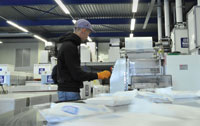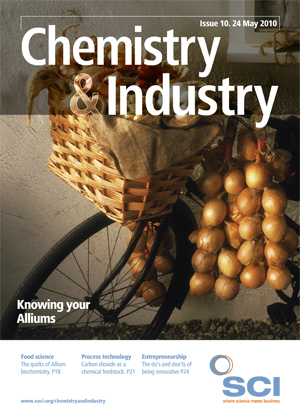Using CO2 as a feedstock for various chemical industry processes should help to make carbon capture technology more competitive, reports Sean Milmo
Carbon capture and sequestration (CCS) will be a key weapon in the fight to curb global warming. However, chemists, chemical engineers and other scientists are still grappling with the massive task of reducing the high costs of carbon capture. Otherwise for power generators and other energy intensive industries, such as iron and steel, cement and petrochemicals, CCS will not be commercially viable even with the assistance of credits from CO2 emissions trading schemes.
Greatly expanding the potential of CO2
One option is the development of technologies that will greatly expand the potential of CO2 as a feedstock for producing fuels and a variety of chemicals, including specialty chemicals and polymers. This would bring added values and revenues to help offset the costs of carbon capture.
‘It will not be sufficient to capture the CO2 and then store it,’ says Paul-Joel Derian, group vicepresident for R&D at Rhodia, which has started a CO2 research programme. ‘We have realised that it would be stupid not to try to utilise CO2 as a raw material.’
Rhodia reckons that by 2050 as much as 10% of the captured CO2 – or up to 1bn t/year –will be used as a raw material. In fact by the middle of the century much of the CO2 emitted by the chemical industry and some other manufacturing sectors could be given what the US Department of Energy (DoE) calls ‘beneficial uses’ as raw materials, intermediates or byproducts.
Over the next decade this segment of addedvalue CO2 will also be a source of new and improved technologies for pushing down the costs of carbon capture in the power sector and other major CO2 emitters. ‘The re-use and recycling of CO2 in industrial applications is helping to improve the technologies being used for carbon capture in the major emitting sectors, like power generation,’ says Stuart Murray, a consultant at the CCS practice of Poeyry Energy Consulting, Oxford, UK.
The development of CO2-derived products is, however, fraught with uncertainties. As with other sets of new technologies, a large proportion of them are likely to fail to reach the market. Among those that succeed, many potential end-users will be sceptical about their quality and environmental advantages.
When the CO2 is re-used, such as for boosting pressure in oil reservoirs to increase oil production, the net energy costs of carbon capture can already be reduced by as much as 20-30%, according to figures from the United Nation’s Intergovernmental Panel on Climate Change (IPCC). The monetary costs of carbon capture in power generation by coal and gas range from $35 to $75/t of CO2, says the Paris-based International Energy Agency (IEA) in a Technology Roadmap on CCS published last year. In fuel-production processes the costs can be as high as $100/t.
With energy-intensive industrial sectors, carbon capture costs range from $55 to 100/t of CO2 for cement, $50-70 for pulp and paper and $60-70 for iron and steel, according to the International Energy Agency (IEA). However, in chemicals production they are much lower at around $30/t and for gas processing, including the manufacture of ammonia, $10-25/t, according to IEA estimates. INTEK, a Virginia-based consultancy in the US, reckons that cost of CO2 capture from hydrogen, ammonia and ethanol plants is $6-12/t. In many cases, the CO2 from these units is reused or recycled.
Among developers of carbon capture technologies, a widely accepted cost target—at least in electricity and fuel production processes— is around $50-60/t in the US and €50/t in Europe.

In the chemical and other industries, there is the advantage of being able to offset the cost of the separation of CO2 in production processes with its sale-on value as a raw material or fuel. Prices for CO2 for reuse are currently over €100/t, depending on levels of purity.
The IEA pinpoints what it calls ‘early opportunities’ for low-cost carbon capture development in segments where CO2 is already being converted into byproducts. These include areas like ammonia and fertiliser manufacture, synthetic fuel production and natural gas processing, which could provide a platform for the development of large-scale CCS technologies.
‘Supporting economically attractive, early opportunity projects paves the way for large-scale CCS deployment,’ the IEA says in its Technology Roadmaps report.
The agency predicts that by 2020 industrial and upstream operations will account for around 60% of about 100 large CCS projects worldwide, backed by investment of $42bn. By 2050, the number of projects could have soared to 3,400 projects, with total investment of $5 trillion, 40-60% of which will be for carbon capture technologies.
A large proportion of these technologies could have initially been developed for applications in the chemicals sector. Mitsubishi Heavy Industries (MHI) of Japan is providing a carbon capture technology for testing in coal plants in the US and the UK, which has mainly been used for recycling CO2 to bolster output of urea in fertiliser plants. MHI technology uses an amine solvent as a CO2 absorbent, a method currently being introduced in electricity generation for carbon capture from flue gas at the post-combustion phase.
Catalysis, including biocatalysis, is also being explored by a growing number of scientists and start-ups as a possible route to carbon capture and conversion into raw materials and chemicals. GreatPoint Energy in Cambridge, Massachusetts, US, has raised over $150m in equity from companies like Dow Chemical and Peabody Energy, to develop its catalytic hydromethanation technology for turning feedstocks like coal and biomass into methane and high purity CO2.
Developing a biocatalysis technology

In Germany, BASF has just announced it has joined a consortium of Heidelberg University, Karlsruhe Institute of Technology (KIT) and the power company Energie Baden-Wuerttemberg (EnBW) to develop a photocatalysis technology to use solar energy to convert CO2 with hydrogen from water into methanol.
Meanwhile, Mantra Venture Group of Seattle in the US is developing a catalytic technology it acquired in 2007 from British Columbia University, Canada, which combines CO2 with water to produce formic acid and formate salts. Formic acid, whose market price has almost doubled over the last few years to $1,400/t, can act as a carrier of liquid hydrogen.
In some potential customer sectors for re-used CO2 or CO2 derivatives, there is, however, a lot of scepticism about products stemming from captured carbon. In the cement and building aggregates sector, a number of start-ups are working on systems for locking CO2 into absorbent materials, which can then be used in construction. They are a method of storing CO2 within building structures, so are carbon negative.
Calera, based in Los Gatos, California, US, has a technology that reacts CO2 and other components of flue gas from power plants with sea or brackish water to form mineral carbonates and bicarbonates for application in construction. Novacem, a spin-out from Imperial College, London, UK, has created a cement, based on magnesium oxide and hydrated magnesium oxides, which absorbs more CO2 over its life cycle than it emits.
In a joint report last year on future cement technologies, however, the IEA and the World Business Council for Sustainable Development (WBCSD) decided to omit carbon-negative cements from their analysis because of current doubts about their economic viability, scalability and quality of the materials. ‘One of the main worries with these technologies is the lack of information about their energy balance, particularly when they are working on an industrial scale,’ says Martin Schneider, managing director of the European Cement Research Academy (ECRA), Dusseldorf, Germany, which helped with the cement technologies study.
Nonetheless, the start-ups in negative carbon cement have the support of some strong partners. Calera has teamed up with the leading construction company Bechtel and Novacem has a development alliance with mining company Rio Tinto.
In the embryonic area of polymer derivatives from CO2, Novomer in Boston, Massachusetts, US, has set up partnerships with specialty polymer companies like Kodak Specialty Chemicals and DSM. Novomer applies a catalyst technology discovered at Cornell University, US, to combine CO2 with epoxies to make aliphatic polycarbonates, with propylene oxide for polypropylene carbonate and with ethylene oxide for polyethylene carbonate.
‘Suitable plants for the capture of the CO2 include ethylene oxide facilities, ethanol plants, natural gas separation units and cement plants, which are attractive sources as all generate a fairly pure, highly concentrated CO2 waste stream,’ says Peter Shepard, vice president, business development at Novomer.
The company’s recently created partnership with DSM, which is an investor in Novomer, will be concentrating on the development of aliphatic polycarbonate resins for coatings. ‘In addition to the environmental and sustainability benefits, the polycarbonate resins will have performance advantages such as durability,’ says Jan Besamusca, innovation director at DSM NeoResins. ‘Also mainstream polycarbonates are aromatic. So aliphatic polycarbonates will be like a new material in the coatings resin market.’
For current developers of CO2 derivatives, the key issue initially will be costs and the amounts of energy consumed to break down the carbon dioxide. ‘It is not only a huge technological challenge but an economical one as well,’ says Rhodia’s Derian.
However, as vast quantities of CO2 are stored underground as a result of a plethora of CCS projects – perhaps as much as 10bn t by 2050— the economics might change because of the glut of excess carbon dioxide which will be available.
Sean Milmo is a freelance writer based in Essex, UK.





